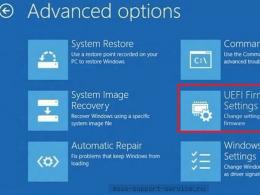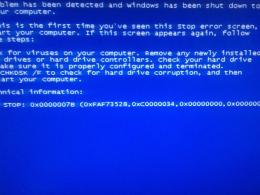Compatibility program not working. Program Compatibility
Windows 7 compatibility mode designed to install and run applications or drivers written for earlier OS versions, such as Windows Vista, Windows XP, etc.
It is recommended that you first check for a software or driver update on the manufacturer's website. If there is no version for Windows 7, you can try installing and running in compatibility mode a program (or driver) designed for Windows Vista or Windows XP. I’ll make a reservation right away that a program launched in this way may not work correctly or not work at all, but for lack of better options, we try to use this one.
Attention! Do not use compatibility mode for system programs such as antiviruses, disk utilities, tweakers, cleaners, etc., as this may damage the system.
Install or run an application using the Program Compatibility Troubleshooter
Compatibility fixes":
Select " Program diagnostics":
Select the version of Windows the program was running on:
Click " Program launch" and make sure the program works, then " Further":
If the app is running select " Yes, save these settings for the program".
If the error persists, click " No, try other options".
Changing compatibility settings manually
Right-click the application's shortcut or setup file (setup.exe, install.exe, etc.) and select " Properties":

Go to tab " Compatibility".
Note: MSI files can only run in compatibility mode with a previous version of Windows.
Run the program in compatibility mode. Enable this option if you know that the program is designed for one or another previous version of Windows (or worked in it):

Install parameters(if necessary):
Note: does not work for 64-bit applications.

Parameter | Description |
Use 256 colors | Restriction of a set of colors in the program. Some older programs use a limited set of colors. |
Use 640×480 screen resolution | Launching the program in a reduced window. Enable this option if the GUI has a jagged outline or does not render correctly. |
Disable visual design | Disabling themes in the program. Enable this option if you have problems with menus or buttons in the program's title bar. |
Disable desktop composition | Turn off transparency and other additional screen features. Enable this option if windows move erratically or if there are other display problems. |
Disable image scaling at high screen resolution | Disable automatic resizing of programs when using large fonts. Enable this option if large fonts disrupt the appearance of the program. |
Run this program as an administrator. Some programs require administrator rights to work properly. This option is available only when logged in with an administrator account.

Change settings for all users. Select settings that will be applied to all users of this computer.

In this article, I have shown how to use Windows 7 Compatibility Mode install an application or driver written for earlier OS versions.
Compatibility mode is not a panacea. To search for other solutions, I invite you to visit our forum, we are always glad to see you.
Programs created for Windows Vista, XP, DOS, or other operating systems may be partially incompatible with the Windows 7 operating system. Read the information in the following sections of this document to learn how to open and use programs in a Windows 7 environment. program may not be compatible with Windows 7. For more information on program compatibility, visit the developer's website.
Troubleshoot a program with the Program Compatibility Troubleshooter
In Windows 7, open the Program Compatibility Wizard window and follow the instructions on the screen:
If the program's compatibility test result is still negative, the program may not be compatible with Windows 7. For more information, visit the program's developer's website.
Troubleshooting Programs from the Start Menu in Windows
If the program is listed in the Windows Start menu program list, try the following troubleshooting steps:

The program is set to run in compatibility mode.
Running Programs in Windows XP Mode
Windows XP Mode and Windows Virtual PC are Microsoft software that allows you to run programs in a simulated Windows XP environment.
Windows XP Mode can be run on a computer running Windows 7 Professional, Enterprise, or Ultimate with support for hardware and BIOS virtualization technology. To find out if a computer supports virtualization technology and enable virtualization for a computer, follow these steps:
Even if the information about the program says in black on the background color that this application is compatible only with some operating systems, among which yours is not, this is not a reason to refuse this program. Although, if you are only choosing an application for yourself, then it is still better to look for an alternative that is supported by your operating system. But if you definitely need exactly the program that is incompatible with your operating system by default, then you can try to make the program compatible with your operating system.
Windows compatibility modes
Windows operating systems have several built-in compatibility modes. These compatibility modes, with the help of special parameters, allow you to reproduce the environment of the operating system that is necessary for the program to work. Naturally, these modes cannot fully reproduce the environment of the desired operating system. Accordingly, they cannot guarantee program compatibility. But still, in many cases, these modes can be a good help. To achieve 100% results, use tools such as .
What do you need to know about these modes? Probably the fact that among the available modes you will not find operating systems that are not from the Windows family. And also the fact that you can only emulate the environment of previous operating systems of the Windows line. For example, on Windows 7 it is possible to reproduce the environment of operating systems from Windows 95 to 7 itself. Eight is not here.
Where to configure program compatibility?
The ability to configure compatibility for programs is located in the properties of the .exe file, on the tab Compatibility. You can find this tab only in the properties of .exe files. Therefore, in order to configure program compatibility, you need to get to the .exe file itself. And for this, you need to install this application on your computer. You can find the necessary .exe file by going to the address that is registered in the properties of the shortcut of the installed application. If the application does not require installation, then finding the right .exe file is easier.
How to automatically configure the compatibility of the program with the operating system?
In this article, only automatic configuration of application compatibility with the operating system will be considered. You can find an article about manual at the link. When automatically adjusting program compatibility, the operating system itself analyzes the program and sets the parameters necessary for its correct launch. To start automatic configuration, on the Compatibility tab, click the button Run the Compatibility Troubleshooter. After a little check, you will see the following window:

Here you are offered two options for the diagnostic mode. The first of these modes will provide you with a list of parameters proposed by the operating system, using which you need to run the program for its compatibility. In this window, you can test the program with the given parameters, and if everything works, ask the operating system to remember this configuration and use them every time you start this program. This option is the easiest and most relaxed. You simply check the configuration suggested by the Program Compatibility Troubleshooter.
The second item, presented in the picture, will open a window in front of you, which will ask you a few clarifying questions related to the compatibility problem of this program. After answering the proposed questions, the operating system will analyze them and, based on them, offer a configuration option in which, theoretically, the program should start correctly.

In many cases where there are program compatibility issues with the Windows operating system, the Program Compatibility Troubleshooter helps resolve the issue. This is how a program incompatible with your operating system can be made compatible and used.
Program compatibility problem is always a problem, especially when a new operating room comes out with new hype. It's been a nightmare for many Vista users, even causing many Vista users to switch back to XP to run their favorite programs and games. Microsoft seems to have learned a lesson from Vista. program compatibility, and they introduced a new Wizard to resolve issues compatibility in Windows 7. No more nightmares like this Windows 7 because Windows 7 has a troubleshooting tool software compatibility issues.To run the Windows compatibility troubleshooter wizard, type Action Center » in the Start menu search box and press enter. Then, in the left pane of the Action Center, click on the link - Troubleshooter to launch the troubleshooting wizard. No more nightmares like this Windows 7, thanks to the Program Compatibility Wizard, which helps solve most Windows compatibility issues.
The first thing to do when you run the troubleshooter Windows compatibility issues, is the choice between extended and normal modes to go further. Although the master program compatibility starts working with the main mode by default, which is good, open "advanced options" at the bottom of the window to get more settings for troubleshooting.
In the window, check the "Advanced options" box. Once you're done, you can simply click the Next button and wait for Windows to create a list of programs after the scanning process is complete.
If the program is not listed in the generated list, select “None” in the list to continue. In the new window, click the browse button, and locate the EXE file from the installed software (usually C:\Program Files).
Click the "Next" button and select the appropriate issue from the "Available" list. Windows will try to fix the error, and will return the result in a few seconds. Again, if your troubles still exist, select the option “Will try different settings” and repeat the procedure with other possible problems.Alternatively, you can also select the shortcut - Method to solve your problem.
*Right click on the program installer and select "Properties".
*Go to the Compatibility tab.
*Now, enable the option “Run this program in compatibility mode for:” and select the operating system “Windows 7”.
*Click the "Apply" button.
*Run the installer to install the software.
You bought yourself a new computer with the Windows 8 operating system installed, or installed it instead of the proven Windows XP or 7. You start customizing the Windows 8 start screen, looking for ways to return gadgets to the desktop. But with the installation of programs familiar to work, not everything is so smooth.
After launching some of them, an information window may appear "This program has compatibility issues". The thing is that not all developers remake utilities for new operating systems.
There is, of course, a solution to this issue. You need to set the compatibility mode of the program with Windows 8. Thus, it will think that it is running in an earlier version of the OS.
Please note that this mode should not be applied to antivirus programs, archivers or system utilities. As a result, this may lead to their incorrect operation.
So, the first thing to do is go to the website of the utility developer and see if a new version is available for download. This should be done in the case when all utility archives are stored on your computer, and after each reinstallation of the OS, you install programs using them.
If you downloaded the installation file from the developer's site, but it is still not compatible with Window 8, then you need to do the following.
Automatic diagnostics
Windows has a built-in helper that can identify and fix a compatibility issue.
To do this, right-click on the program shortcut on the desktop, or on its installation file, and select the context menu item "Fix Compatibility Issues".
Next, it is proposed to select one of the diagnostic modes. When choosing "Use recommended settings"- the system will run the utility in test mode and determine the appropriate parameters itself. Select the "Diagnostics ..." mode if you yourself can indicate the compatibility problems that have arisen.

Click on the first item. In the next window, click "Check program...", the process will be similar to the installation process. Then click "Next".

If everything worked out, click "Yes, save these settings for the program". If the problem has not been resolved, select the second option. Then you will be able to mark the compatibility problem yourself and select the version of the OS in which the utility worked.

Manual Troubleshooting
Right-click on the program shortcut on the desktop and select "Properties".

Now go to the tab "Compatibility". Button "Run Compatibility Troubleshooter" will allow you to complete all the steps from the previous paragraph. Check the box "Run this program in compatibility mode for" and select an operating system. If you have an older utility that uses limited colors, select "Reduced Color Mode".
If it requires administrator rights, check the box "Run this program as an administrator"(if you are logged in under an account without administrator rights, this field will be inactive).
To apply the configured settings to all users, click the button "Change settings for all users".
To save the compatibility settings, click OK.







